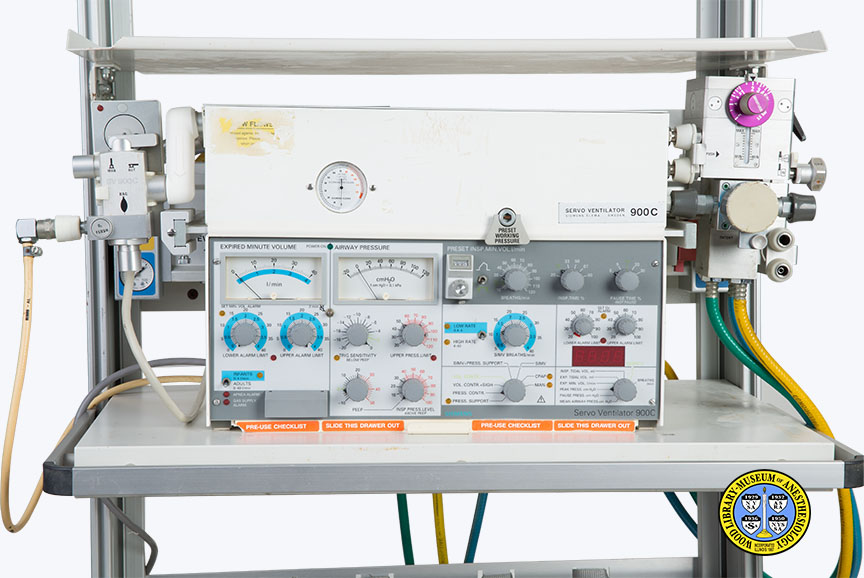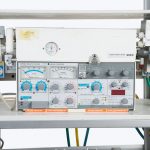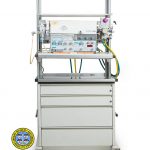Siemens Servo Ventilator 900C
Control of the Siemens Servo Anesthesia System was concentrated in the ventilator. In this case, it is the Servo Ventilator 900C. A ventilator helps a patient breathe effectively. The 900C was used to administer vaporized anesthetic gas, nitrous oxide, oxygen and air with the patient's breaths. Besides tubing that delivered air to and from the patient, this ventilator was attached to anesthesia specific equipment, such as anesthetic vaporizers.
A very sophisticated ventilator when introduced by Siemens in 1981, the Servo 900C had a single-circuit, with spring-driven bellows, that was pneumatically powered and electronically controlled. The ventilator modes available included volume or pressure control, pressure support, and synchronized intermittent mechanical ventilation. The 900C could also be used to aid ventilation with positive end-expiratory pressure (PEEP), continuous positive airway pressure (CPAP), and negative end-expiratory pressure (NEEP).
Used for children and adults, the Servo 900C also monitored a number of parameters, such as airway pressure, tidal volume, and respiratory rate. Add-on units could measure carbon dioxide production and ventilator parameters. Alarms could be set at desired values for the monitored parameters. The Servo 900C was also used in intensive care units for patients who needed complex breathing support. In the operating room, it allowed the anesthesiologist to effectively care for a broad spectrum of critically ill and healthy patients during surgery.
Catalog Record: Servo Anesthesia System 900C
Access Key: altg
Accession No.: 2008-08-18-1 A
Title: [Servo anesthesia system] 900C.
Corporate Author: Siemens-Elema AB.
Title variation: Alt Title
Title: Siemens-Elema anesthesia system.
Title variation: Alt Title
Title: Siemens anesthesia machine.
Title variation: Alt Title
Title: Siemens-Elema anesthesia machine.
Title variation: Alt Title
Title: Servo anesthesia machine.
Publisher: Sweden : Siemens-Elema AB, [1984].
Physical Descript: 1 anesthesia machine : metals, plastics, glass, rubber : 182 x 90 x 85 cm.
Subject: Anesthesia Machines – computerized.
Subject: Anesthesia, Inhalation – instrumentation.
Subject: Ventilators, Mechanical.
Subject: Respiration, Artificial – instrumentation.
Note Type: General
Notes: The date of manufacture was provided by the donor, Eric Henricks, MD. Dr.
Henricks purchased the machine new from the manufacturer in December of 1984.
Note Type: General
Notes: The title is based on company product literature and advertisements in which
the anesthesia systems in general are referred to as, “Servo anesthesia
system” (1984) and a system with the Servo 900 C ventilator is referred to as
the “Servo Anesthesia System 900C” (1991).
Note Type: Citation
Notes: Anaesthetic-Related Equipment: Purchase, Maintenance and Replacement. London:
Association of Anaesthetists of Great Britain and Ireland; 1994:16.
https://www.aagbi.org/sites/default/files/relatedequipment94.pdf. Accessed
March 20, 2015.
Note Type: Citation
Notes: Davey AJ, Diba A, eds. Ward’s Anaesthetic Equipment. Edinburgh: Saunders,
Elsevier; 2012:266-267, 237.
Note Type: Citation
Notes: Kacmarek RM. The mechanical ventilator: past, present, and future. Respir
Care. 2011;56(8):1173-1175. https://rc.rcjournal.com/content/56/8/1170.full.
Accessed May 4, 2015.
Note Type: Citation
Notes: McPherson SP. Pneumatically driven, electronically controlled, adult
ventilators. In: Respiratory Therapy Equipment. St. Louis: C.V. Mosby
Company; 1985:481, 487-488, 491.
Note Type: Citation
Notes: Servo Anesthesia System: Servo Ventilator in the Operating Room [brochure].
Solna, Sweden: Siemens-Elema AB, September, 1984.
Note Type: Citation
Notes: Servo simplicity: Servo Centilator 900C [advertisement]. Br J Anaeth.
1981;53(11):[unnumbered pages].
Note Type: Citation
Notes: Siemens. Simply the best!: The Servo Anesthesia System 900C is the most
advanced system [advertisement]. Br J Anaesth. June, 1991;66(6):xiii.
Note Type: Citation
Notes: Siemens. Sometimes the chicken comes before the egg.: the new Servo
Ventilator 900C has all the possibilities of keeping abreast of science for
many years ahead [advertisement]. Br J Anaesth. 1983;55(4):[8-9 of
advertisements].
Note Type: Physical Description
Notes: One mostly white colored anesthesia machine; The most prominent feature of
the machine is the ventilator seated on the shelf above the four drawers; The
ventilator is mostly white in color, with grey areas on the control panel in
front; A few areas of the front panel are highlighted in a bright blue, and
the text is in black, red, blue and green; The ventilator bears the following
manufacturer markings on the upper right front of the machine, “SERVO
VENTILATOR [new line] SIEMENS-ELEMA SWEDEN”; To the right of these lines in
larger letters is, “900C”; Marked in the lower right corner of the front of
the ventilator is, “SIEMENS” in blue, and “Servo Ventilator 900C” in black;
Connected to the right side of the ventilator is an “ISOFLURANE VAPORIZER
952” and a “HALOTHANE VAPORIZER 950”; The connection and support for the
breathing system is on the left side of the ventilator; On the back of the
ventilator are a number of input/output computer ports, an operating time
meter, the POWER switch, and the plug for the main power source; A label on
the back of the ventilator is marked with, “SIEMENS-ELEMA AB [new line] Mod.
No. 93 11 267 E359E [new line] Ser. No. 04214 S11 [new line] MADE IN SWEDEN”;
A maintenance sticker on the right side of the ventilator is marked with,
“CLARIAN Clinical Engineering [new line] INSPECTED ON _-08-02”; Located
behind the ventilator is the gas supply manifold; On each side of the
manifold are gauges for oxygen (in green), air (in yellow), and nitrous oxide
(in blue); From left to right, ports marked on the manifold include, “EVAC”
with an upward pointing arrow, “AIR/LUFT” with a downward pointing arrow,
“EVAC” with a downward pointing arrow; “O2” with an upward pointing arrow,
“AIR/LUFT” with an upward pointing arrow, “N2O” with an upward pointing arrow
“”MIX” with a downward pointing arrow, “O2” with a downward pointing arrow,
“AIR/LUFT” with a downward pointing arrow, “N2O” with a downward pointing
arrow, “O2” with a downward pointing arrow, and “AIR/LUFT” with a downward
pointing arrow; The ports are accessible mostly from the back of the machine;
On the back of the machine, or system, on the upper left of the upper most
bar, is a label marked with, “Mod. No. 90 81 282 E345E” and “Ser. No. 01056
11”, and “SIEMENS-ELEMA AB”, and “MADE IN SWEDEN”.
Note Type: Reproduction
Notes: Photographed for the WLM by Mr. Steve Donisch, January 14, 2015.
Note Type: Acquisition
Notes: Donated to the WLM by Eric Henricks, MD. Donation facilitated by William
McNiece, MD. Dr. Henricks purchased the machine in December of 1984 and used
it until 2002. On his system Dr. Hendricks reported, ‘The machine functioned
flawlessly all those years and was still perfectly operational when it was
“retired”.’
Note Type: Historical
Notes: Control of the Servo Anesthesia System was concentrated in the ventilator. In this case, it is the Servo Ventilator 900C. A ventilator helps a patient breathe effectively. The 900C was used to administer vaporized anesthetic gas, nitrous oxide, oxygen and air with the patient’s breaths. Besides tubing that delivered air to and from the patient, this ventilator was attached to anesthesia specific equipment, such as anesthetic vaporizers.
A very sophisticated ventilator when introduced by Siemens in 1981, the Servo 900C had a single-circuit, with spring-driven bellows, that was pneumatically powered and electronically controlled. The ventilator modes available included volume or pressure control, pressure support, and synchronized intermittent mechanical ventilation. The 900C could also be used to aid ventilation with positive end-expiratory pressure (PEEP), continuous positive airway pressure (CPAP), and negative end-expiratory pressure (NEEP).
Used for children and adults, the Servo 900C also monitored a number of parameters, such as airway pressure, tidal volume, and respiratory rate. Add-on units could measure carbon dioxide production and ventilator parameters. Alarms could be set at desired values for the monitored parameters. The Servo 900C was also used in intensive care units for patients who needed complex breathing support. In the operating room, it allowed the anesthesiologist to effectively care for a broad spectrum of critically ill and healthy patients during surgery.
Note Type: Exhibition
Notes: Selected for the WLM website (noted March 19, 2015).



